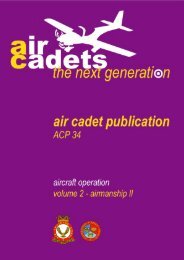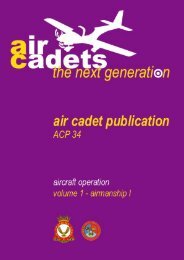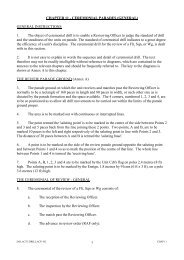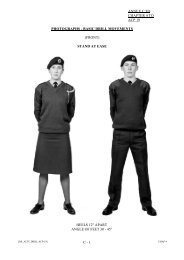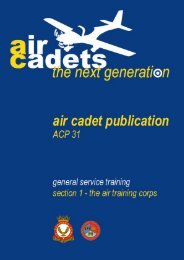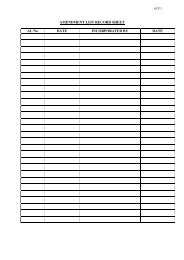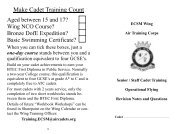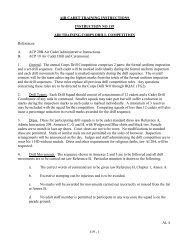Leading Cadet ECSM Wing Revision Guide - 967 Air Cadets
Leading Cadet ECSM Wing Revision Guide - 967 Air Cadets
Leading Cadet ECSM Wing Revision Guide - 967 Air Cadets
Create successful ePaper yourself
Turn your PDF publications into a flip-book with our unique Google optimized e-Paper software.
CHAPTER 4 WEATHER<br />
There are six main air masses that affect the<br />
weather in the British Isles, each having its own<br />
distinctive characteristics. To complicate matters,<br />
these characteristics also change by season.<br />
<strong>Air</strong> Masses<br />
Look at the figure below for the next five questions.<br />
In normal flight conditions the wing is inclined to<br />
the oncoming airflow at a slight positive angle.<br />
This deflects some of the airflow downwards<br />
creating a ‘downwash’ which adds to the lift<br />
generated by the top surface of the wing.<br />
Where is the greatest amount of lift normally generated on<br />
an aerofoil?<br />
a) Top surface. b) Bottom surface.<br />
c) Trailing edge. d) <strong>Leading</strong> edge.<br />
Lift is obtained from almost all parts of the wing but not<br />
equally from every part. About how much is obtained<br />
from the top surface of an aircraft wing?<br />
V<br />
a) Up to 80%. b) Up to 50%.<br />
c) Up to 33%. d) Up to 25%.<br />
Which air mass is called Arctic Maritime?<br />
a) V b) W c) X d) Y e) Z<br />
Under these flight conditions all parts of a wing<br />
generate lift, though to varying degrees.<br />
This diagram illustrates several important points:<br />
On a general purpose aerofoil, the greatest amount of lift<br />
occurs:<br />
a) Just forward of the trailing edge.<br />
b) At the centre of the bottom surface.<br />
c) Where the top surface is not curved.<br />
d) Where the top surface is curved the most.<br />
Which air mass is called Tropical Maritime?<br />
a) V b) W c) X d) Y e) Z<br />
In what direction relative to the direction of the oncoming<br />
air, or path of the aircraft, do the lift forces act?<br />
Polar Maritime<br />
Originates in North Canada and Greenland, picks<br />
up water vapour from the Atlantic before reaching<br />
the British Isles.<br />
Summer: cool winds, heavy showers.<br />
Winter: heavy showers in west, clear in east.<br />
Returning Polar Maritime<br />
Originates in Canada as cold, dry air, but moves<br />
south and picks up a lot of water vapour. It is much<br />
warmer and wetter than Polar Maritime air.<br />
Summer: warm with squally showers and storms.<br />
Winter: low stratus cloud, showers in mountains.<br />
Tropical Maritime<br />
Originates in warm tropical oceans around the<br />
equator and brings cloudy, warm and wet air all<br />
year round.<br />
Summer: warm SW winds, low stratus clouds.<br />
Winter: mild, low stratus, drizzle, mountain rain.<br />
Tropical Continental<br />
Originates in North Africa.<br />
Summer only: very hot, dry, hazy, occasional<br />
thunderstorms.<br />
36<br />
Which air mass is called Tropical Continental?<br />
a) V b) W c) X d) Y e) Z<br />
Which air mass is called Polar Maritime?<br />
a) V b) W c) X d) Y e) Z<br />
Which air mass is called Polar Continental?<br />
a) V b) W c) X d) Y e) Z<br />
Which air mass starts off very cold with dry air but arrives<br />
in the U.K. warm and wet?<br />
a) Arctic Maritime. b) Polar Maritime.<br />
c) Returning Polar Maritime. d) Tropical Continental.<br />
Which air mass originates around the equator and brings<br />
warm, cloudy weather to the U.K. in both summer and<br />
winter?<br />
a) Arctic Maritime. b) Polar Maritime.<br />
c) Tropical Continental. d) Tropical Maritime.<br />
Which air mass originates in North Africa and brings hot,<br />
dry weather with occasional thunderstorms to the U.K. in<br />
summer?<br />
a) Arctic Maritime. b) Polar Continental.<br />
c) Tropical Continental. d) Tropical Maritime.<br />
Which air mass originating in Siberia brings to the U.K.<br />
warm weather in summer and cold weather in winter?<br />
a) Arctic Maritime. b) Polar Continental.<br />
c) Tropical Continental. d) Tropical Maritime.<br />
Which air mass originates in the north of Canada and<br />
Greenland, brings cool winds and heavy showers to the<br />
UK both summer and winter?<br />
a) Polar Continental. b) Polar Maritime.<br />
c) Tropical Continental. d) Arctic Maritime.<br />
a) the top surface normally generates more lift<br />
than the bottom surface (sometimes 80% of it).<br />
b) the greatest amount of lift on the top surface<br />
occurs where the surface is curved the most.<br />
c) all lift forces act at 90° to the oncoming airflow.<br />
All of these lift forces can be combined and represented<br />
by a single arrow from the ‘centre of pressure’<br />
where all lift forces can be said to act.<br />
Factors Affecting Lift<br />
This is similar to finding the<br />
centre of gravity of a ruler. All<br />
the small forces of gravity<br />
acting on the ruler balance<br />
about the centre of gravity.<br />
Several factors affect the amount of lift a wing<br />
produces. At subsonic speeds, doubling the airspeed<br />
gives four times the lift, trebling the airspeed<br />
gives nine times the lift.<br />
Increasing the ‘angle of attack will increase lift<br />
until the angle reaches about 15°.<br />
Angle of attack is the angle between the chord<br />
line of a wing and the oncoming air.<br />
5<br />
a) At about 4 degrees. b) The opposite direction.<br />
c) At 90 degrees. d) The same direction.<br />
The point on a wing at which all the lift forces are said to<br />
act is:<br />
a) Centre of pressure. b) Dynamic centre.<br />
c) Pressure point. d) Static point.<br />
In the figure on the left, all the small forces of gravity<br />
acting on the ruler balance at a point called:<br />
a) The static centre. b) The centre of gravity.<br />
c) The centre of pressure. d) The dynamic centre.<br />
If an aircraft's speed through the air is increased from 250<br />
kts to 500 kts, what happens to the amount of lift produced?<br />
a) It is increased by four times. b) It is doubled.<br />
c) It is reduced to a quarter. d) It remains the same.<br />
For low subsonic speeds, if the airspeed is doubled and all<br />
other factors affecting lift are unchanged, the lift is:<br />
a) Unchanged. b) Multiplied by 2.<br />
c) Multiplied by 4. d) Multiplied by 8.<br />
On an aircraft, if the airspeed over a wing is trebled and<br />
all other factors affecting lift are unchanged, the lift is:<br />
a) Multiplied by about 3. b) Divided by about 3.<br />
c) Unchanged. d) Multiplied by about 9.<br />
Angle of attack means:<br />
a) The angle between the chord line of the wing and the<br />
oncoming air.<br />
b) The angle of sweepback of a wing.<br />
c) The amount by which the aircraft's nose is above the<br />
horizon in level flight.<br />
d) The angle at which a wing is fixed to the fuselage.



